- GitHub Copilot: Generates code, completes functions, and integrates with popular IDEs like VS Code and JetBrains.
- Tabnine: Offers smart, context-aware code completions and supports custom training on your codebase.
- Kite: Local-first processing for secure, offline coding assistance, focused on Python and JavaScript.
- SonarLint: Real-time code quality analysis with over 6,000 rules to catch bugs and vulnerabilities.
- DeepCode (by Snyk): AI-powered static analysis for security and performance issues in 19+ languages.
- Sourcery: Python-specific tool for automated refactoring and improving code quality.
- Ozcode: Debugging tool with real-time error tracking and "time-travel" debugging for production environments.
- OpenAI Codex: Converts natural language into code for multiple languages and powers GitHub Copilot.
- Replit Ghostwriter: Built-in AI assistant for the Replit IDE with real-time suggestions and explanations.
- AI Apps Directory: A curated collection of 1,000+ AI tools for coding, debugging, and project management.
Quick Comparison Table
| Tool | Key Feature | Languages Supported | IDE Integration |
|---|---|---|---|
| GitHub Copilot | Code generation and completion | Python, JS, Java, C++ | VS Code, JetBrains, Neovim |
| Tabnine | Context-aware code completions | Python, JS, Java, Go, Ruby | VS Code, IntelliJ, Eclipse |
| Kite | Local processing for privacy | Python, JS, Go | VS Code, PyCharm, JupyterLab |
| SonarLint | Real-time code quality analysis | Java, JS, Python, C++, C# | VS Code, IntelliJ, Eclipse |
| DeepCode (Snyk) | AI-powered static code analysis | 19+ languages | IntelliJ, PyCharm, WebStorm |
| Sourcery | Python-focused refactoring | Python | VS Code, PyCharm, GitHub |
| Ozcode | Time-travel debugging | C# | Visual Studio, Azure DevOps |
| OpenAI Codex | Natural language to code | Python, JS, Go, SQL | VS Code, CLI |
| Replit Ghostwriter | Real-time code suggestions | 50+ languages | Replit IDE |
| AI Apps Directory | Curated AI tools for developers | Various | N/A |
These tools make coding faster, reduce errors, and help developers focus on solving complex problems. Whether you're debugging, refactoring, or generating code, there's a free AI tool to help in 2025.
10 AI Coding Tools You Need to Stay Ahead in 2025
1. GitHub Copilot
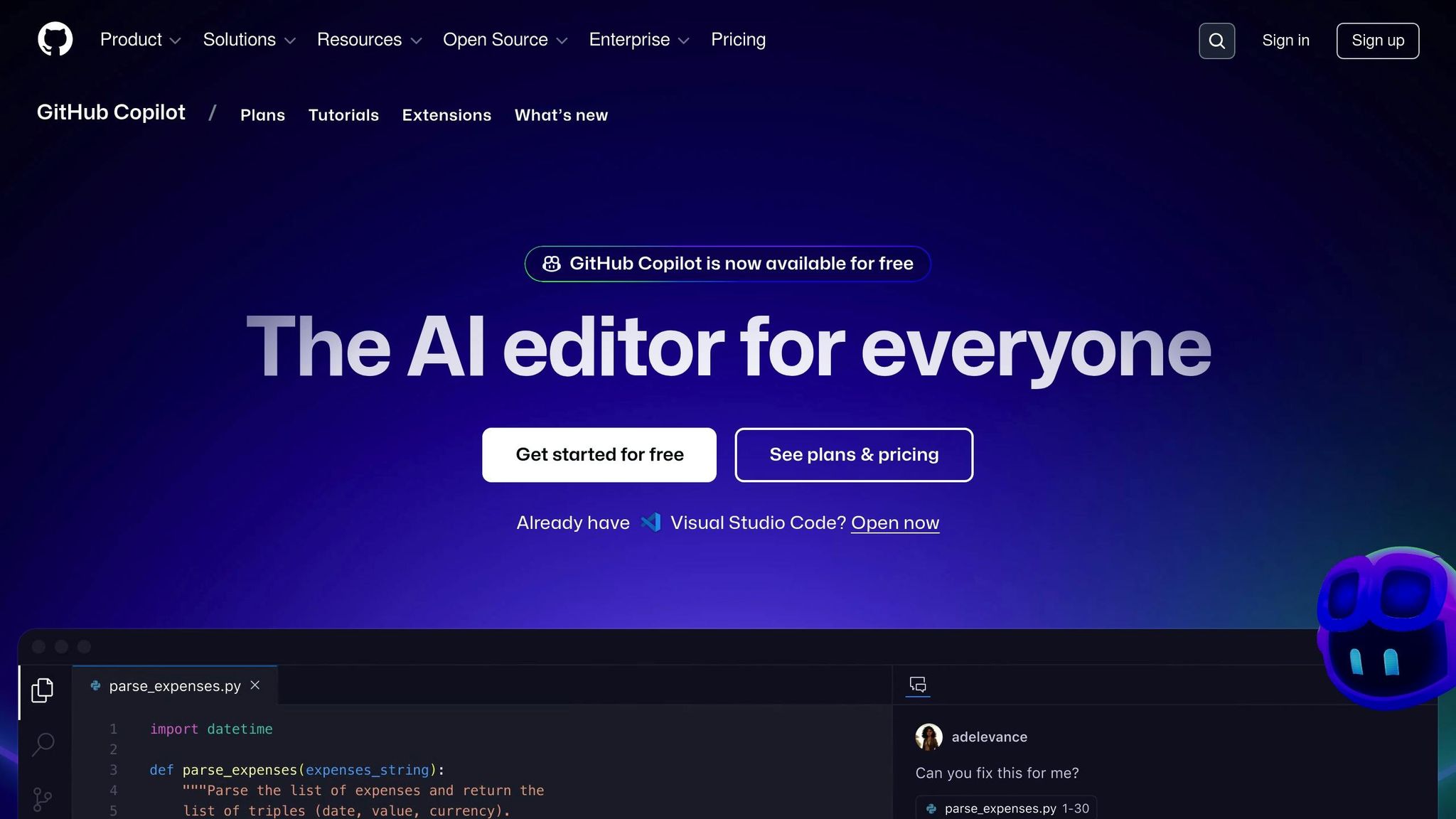
GitHub Copilot, created through a collaboration between Microsoft GitHub and OpenAI, is powered by OpenAI Codex. This tool integrates seamlessly with popular IDEs, providing instant code suggestions and making it a go-to resource for developers.
It turns natural language descriptions into fully functional code blocks, using comments and context to generate complete functions or segments. This capability makes it highly effective for speeding up coding tasks and debugging.
Key Features
- IDE Integration: Compatible with Visual Studio, VS Code, JetBrains IDEs, and Neovim.
- Copilot Chat: Offers in-IDE coding assistance and answers to queries.
- CLI Support: Provides command suggestions and explanations.
- Pull Request Analysis: Summarizes code changes for better review efficiency.
Copilot allows you to write code faster with less effort, so you can focus on solving complex problems. Keeping related files open in your IDE improves its context awareness and accuracy. Plus, it adjusts to your coding style, ensuring your code stays consistent.
Highlights
- Code Completion: Generates entire functions and code blocks.
- Multi-language Support: Works with Python, JavaScript, Ruby, C++, and more.
- Context Awareness: Tailors suggestions based on your project.
- Debugging Assistance: Identifies issues and offers solutions.
GitHub Copilot shines when it comes to tasks like quick code generation and completion. For more complex or project-wide requirements, it may need additional context. Its easy setup and strong integration with widely-used development tools make it accessible for developers of all experience levels.
When debugging, Copilot simplifies the process by analyzing call stacks, frames, and variable contexts. It can even suggest conditional breakpoints and tracepoints to help you pinpoint issues efficiently.
2. Tabnine
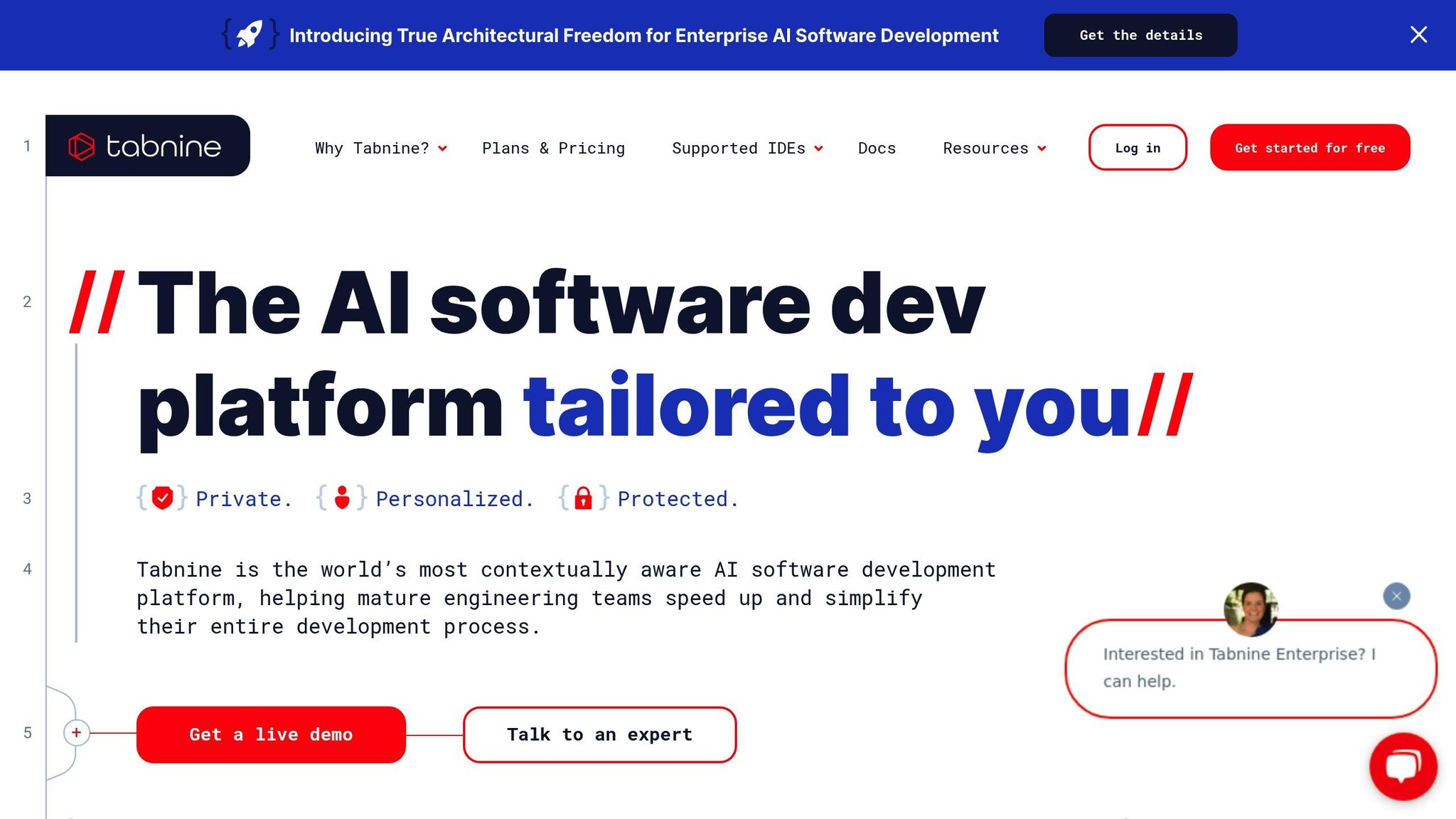
Tabnine is designed to make coding faster and smoother with its smart code completion features. Highlighted in Gartner® Critical Capabilities for AI Code Assistants, it ranks highly in areas like code generation, debugging, and explanation use cases.
Key Features and Capabilities
Tabnine's AI adapts to your coding habits and project needs, offering tailored suggestions that keep your code consistent. It can even learn from your organization's existing codebase to create custom models, improving the relevance of its suggestions.
It integrates with many popular IDEs, including:
- Visual Studio Code
- IntelliJ
- Eclipse
- Android Studio
- PyCharm
- WebStorm
Language Support Matrix
| Language | Support Level | Chat Available |
|---|---|---|
| JavaScript/TypeScript | High | Yes |
| Python | High | Yes |
| Java | High | Yes |
| React/Vue | Moderate | Yes |
| Go/Ruby/PHP | Moderate | Yes |
| C/C++/C# | Moderate | Yes |
Real-World Impact
At CI&T, developers accept 90% of Tabnine's single-line coding suggestions, which has led to an 11% boost in productivity across their projects.
"Tabnine has helped us to ensure code consistency across our organization, resulting in faster and more efficient code reviews. Just as important, our developers love working with it."
– Amit Tal, VP Engineering, ReasonLabs
Privacy and Security
Tabnine offers flexible deployment options to protect your code, including on-premises setups, virtual private cloud (VPC) deployment, and secure SaaS solutions.
Advanced Features
Tabnine goes beyond code completion by offering tools for testing, code review, documentation, and even Jira integration. Enterprise users can train private models on proprietary codebases, ensuring suggestions are tailored to their specific needs.
Performance Considerations
While Tabnine delivers powerful features, it can require more system memory. However, many developers find the productivity improvements worth the trade-off. Its capabilities make it a strong option in the growing field of AI-powered coding tools.
3. Kite
Kite is an AI coding assistant designed with privacy in mind. It runs directly on your machine, ensuring your code stays secure by avoiding cloud-based processing. With machine learning models trained on over 25 million open-source code files, Kite provides smart coding suggestions right in your favorite IDE.
Performance and User Experience
Kite's performance stats are impressive. Studies reveal a 92% onboarding success rate, with 32% of users finding it "very easy" to get started. Active users benefit from around 175 AI-suggested words daily.
Language Support and Integration
Kite works seamlessly across a variety of programming languages and development environments:
| Feature | Details |
|---|---|
| Primary Languages | Python, JavaScript, Go |
| Secondary Support | Java, PHP, C/C++, TypeScript, Ruby |
| Framework Support | React, Vue, Kotlin, Scala |
| IDE Integration | VS Code, PyCharm, IntelliJ, JupyterLab, Vim, Sublime |
These integrations enhance Kite's ability to deliver intelligent coding assistance.
Key Features
Kite's free version includes several standout features:
- Local Processing: All computations happen on your machine, allowing offline use.
- Smart Autocompletions: Suggestions are marked with the ⟠ symbol for easy identification.
- Quick Documentation: Get instant hover summaries and function signatures.
- Multi-Line Suggestions: Receive context-aware recommendations for entire code blocks.
- Python-Focused Features: Special tools tailored for Python developers.
Enterprise Capabilities
For teams needing extra power, Kite offers an enterprise version. This version uses GPU acceleration to deliver faster and more precise suggestions, making it ideal for high-demand environments.
Technical Implementation
Kite's architecture is based on GPT-2, chosen for its balance between speed and compatibility. Unlike newer models like GPT-3, GPT-2 avoids high latency and fits comfortably on local machines. Kite CEO Adam Smith explains this choice as prioritizing practical usability, ensuring the tool remains efficient for developers.
Privacy and Security
Kite's local-first design comes with several benefits:
- Efficiency: Optimized for local processing without sacrificing performance.
- Data Security: All processing stays on your machine, keeping your code private.
4. SonarLint
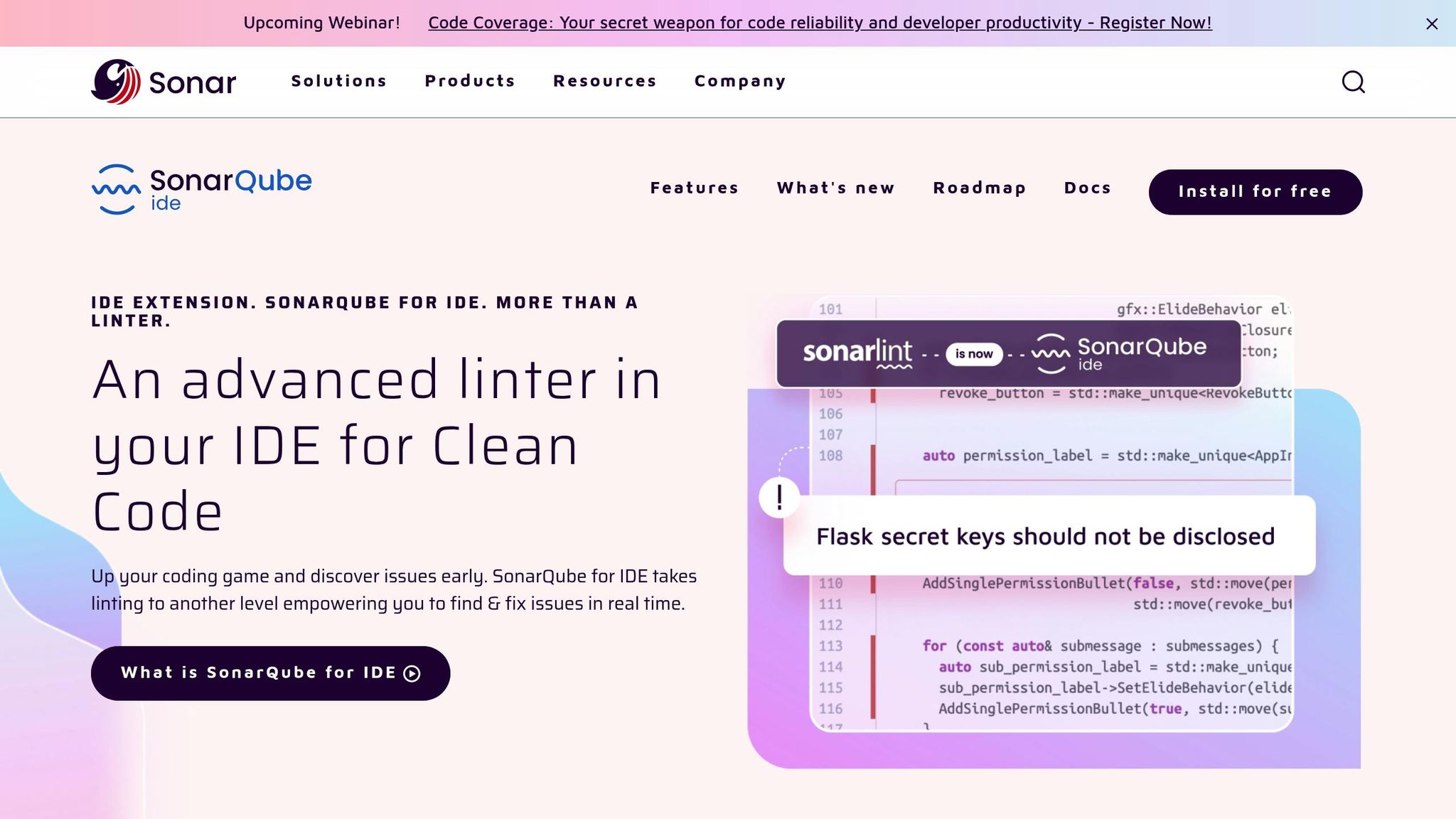
SonarLint is a free, open-source code analyzer that provides real-time feedback. Trusted by 7 million developers and over 400,000 organizations, it's a go-to tool for maintaining code quality and security.
Core Features and Capabilities
SonarLint helps developers catch and fix issues early in the coding process. Here's what it offers:
| Feature | What It Does |
|---|---|
| Real-time Analysis | Gives instant feedback as you code |
| Quick Fixes | Automates corrections with one click |
| Security Scanning | Flags vulnerabilities early |
| Multi-language Support | Works with Java, JavaScript, Python, C#, C++ |
| IDE Integration | Compatible with VS Code, IntelliJ, Eclipse |
Smart Detection System
SonarLint uses over 6,000 rules to scan your code in the background, offering immediate insights into:
- Security risks
- Code quality problems
- Potential bugs
- Violations of coding standards
- Indicators of technical debt
Enterprise Integration
When paired with SonarQube or SonarCloud, SonarLint ensures consistent code quality across teams. This integration is especially helpful for large organizations, as it creates a unified development environment where quality checks run seamlessly.
"The greatest impact it's had has been that it has allowed us to focus our effort on making sure new code is clean instead of addressing technical debt." - Bijay Mangaraj, Senior Vice President
Performance Impact
SonarLint operates in the background, keeping your IDE running smoothly while maintaining high-quality code standards. Its analysis engine provides helpful, contextual guidance without disrupting your workflow.
Security-First Approach
SonarLint's ability to detect and fix vulnerabilities as you code makes it a great choice for teams working on sensitive projects or under strict compliance requirements.
"SonarLint is like having a coding buddy that helps you become a better programmer. As you write code, it's like having a teacher right there with you, pointing out ways to improve." - Okosa Leonard, Frontend Developer
5. DeepCode
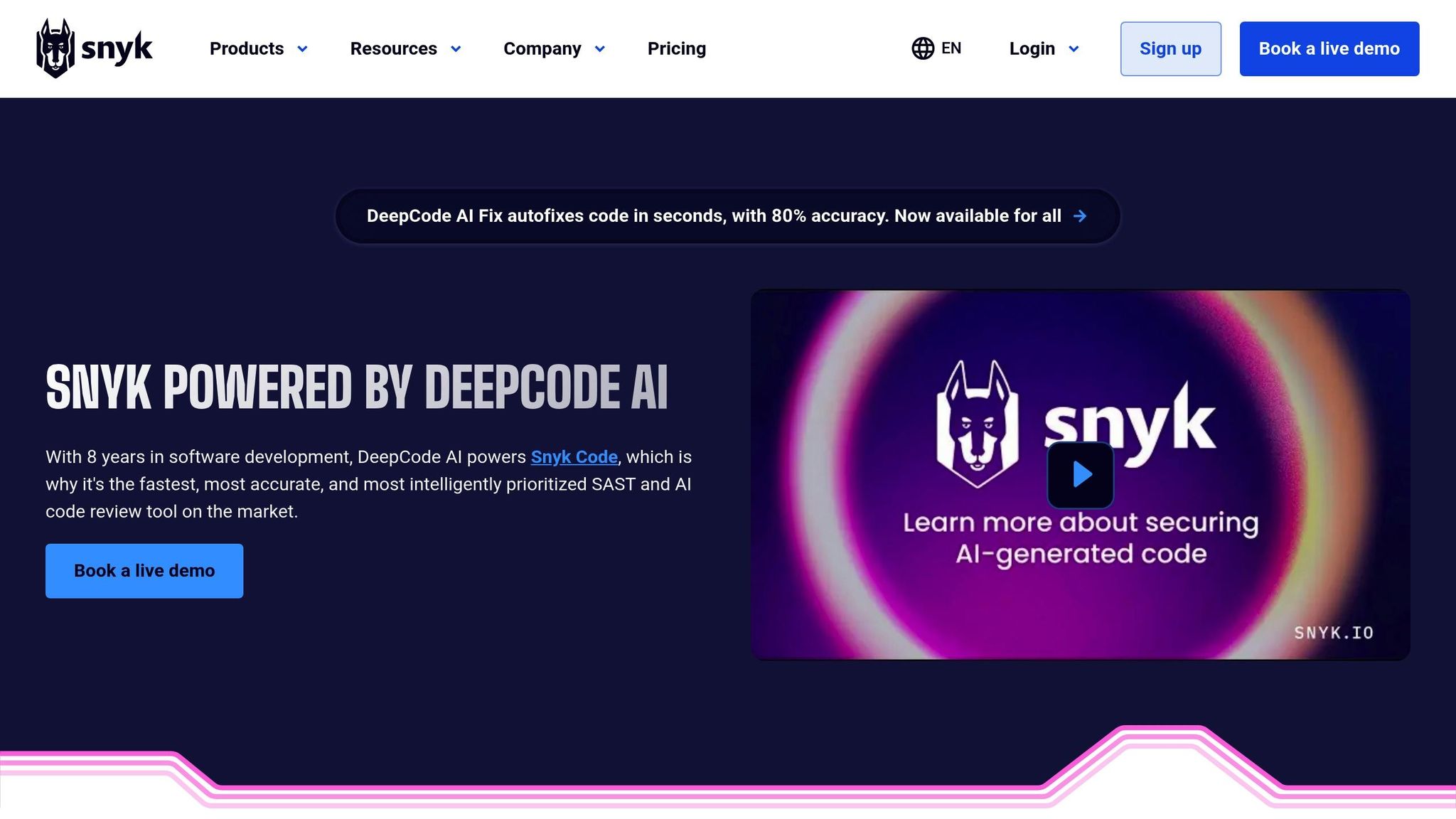
DeepCode takes code analysis to the next level by combining AI detection with fix recommendations. Now part of Snyk Code, it uses machine learning trained on over 25 million data flow cases to analyze code in more than 19 programming languages.
Advanced Detection Capabilities
DeepCode utilizes both symbolic AI and machine learning, breaking down code into an abstract syntax tree (AST) for accurate issue detection. Here’s how it helps:
| Detection Type | Features |
|---|---|
| Security Issues | Scans in real-time using the Snyk vulnerability database |
| Bug Detection | Spots subtle bugs and logical errors |
| Performance Issues | Identifies areas impacting code performance |
| Technical Debt | Highlights and prioritizes necessary code improvements |
Language Support and Speed
DeepCode supports major programming languages and is designed for speed. It can scan the Chromium project (about 16 GB of source code) in just minutes and analyze the Linux source code in around 6 minutes.
Integration and Workflow
DeepCode works seamlessly with popular development tools. It integrates with IDEs like IntelliJ, PyCharm, and WebStorm, and connects easily to leading version control systems.
AI-Powered Fix Recommendations
The AI Fix feature can automatically fix code in seconds, with an impressive accuracy rate of 80%. Every fix is pre-scanned to ensure it doesn’t introduce new security issues, making it a powerful addition to development workflows.
"When it comes to developer productivity gains, the recent explosion of generative AI innovation has been welcomed by many with a mixture of enthusiasm and relief. As a security leader, however, my foremost responsibility is to ensure that all of the code we create, whether AI-generated or human-written, is secure by design. By using Snyk Code's AI static analysis and its latest innovation, DeepCode AI Fix, our development and security teams can now ensure we're both shipping software faster as well as more securely."
– Steve Pugh, CISO, ICE/NYSE
Practical Implementation
DeepCode’s unique approach offers two standout advantages:
"First, based on our proprietary implementation of the solver engine, we are able to use large open-source codebases as training data. Second, we use an augmented AI approach where our engineers work on an abstraction level higher than the competition and are supported by a semi-supervised learning system to produce symbolic AI constraint rules. The data used to train the system is only available at scale due to our performance advantage. With this, we were able to leapfrog the whole industry after just three months of focus."
– Boris Paskalev, CEO of DeepCode
Performance Metrics
DeepCode detects 10 times more critical issues than traditional tools and reduces remediation time by over 84%. Developers can further streamline scans by using a .dcignore file to exclude certain files and adjust severity thresholds.
sbb-itb-212c9ea
6. Sourcery
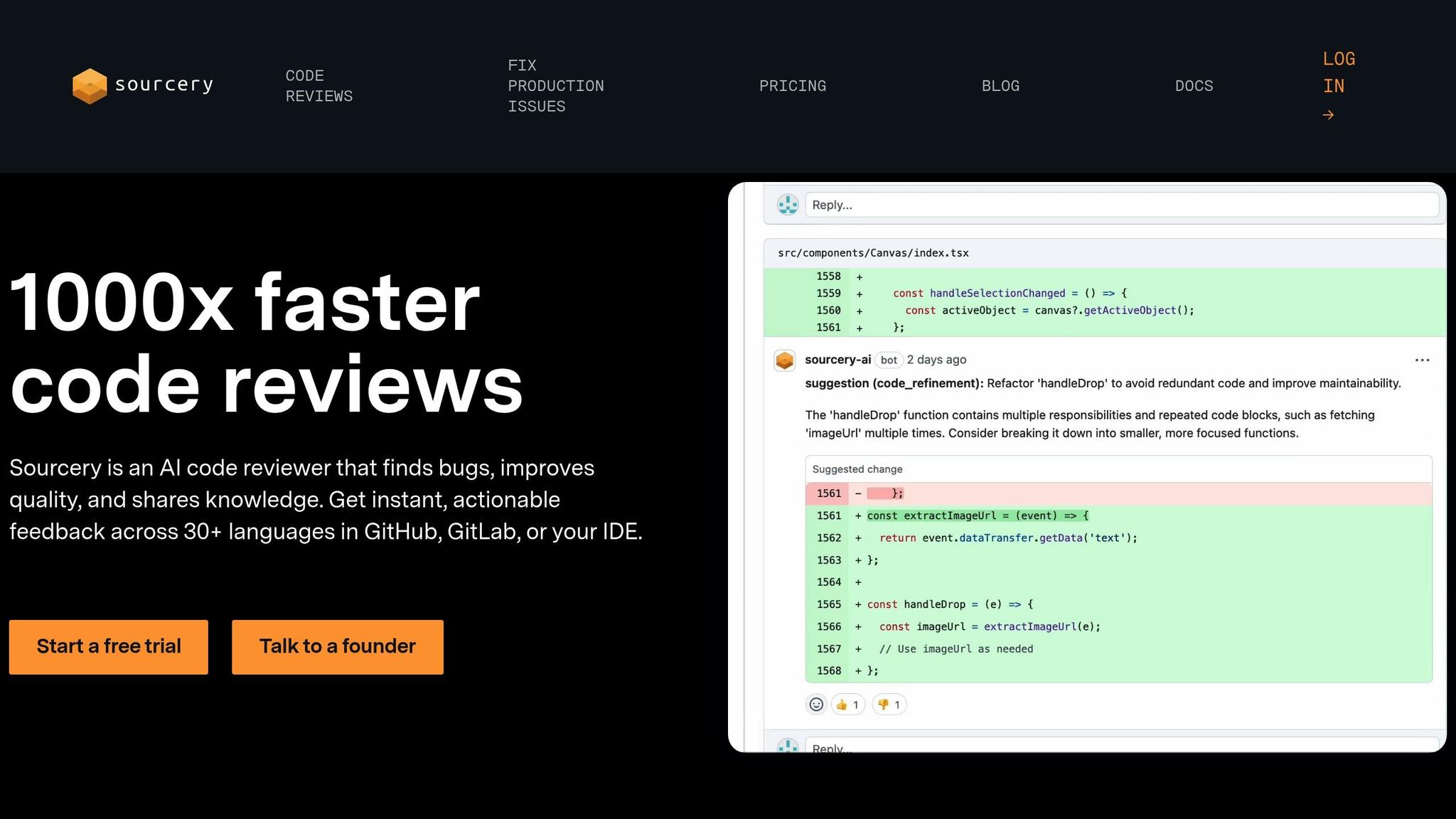
Now let's dive into Sourcery - a Python-focused tool designed to refine and improve your code. This free AI-powered tool provides instant refactoring suggestions and automated code reviews, making it a go-to for Python developers.
Real-Time Code Feedback
Sourcery's AI evaluates your Python code as you write, offering feedback on several metrics:
| Quality Metric | What It Measures |
|---|---|
| Method Length | How concise and modular your code is |
| Complexity | The cognitive load and ease of maintenance |
| Variable Efficiency | How effectively variables and logic are used |
| Overall Quality | A combined score across all metrics |
Smart Refactoring Features
Sourcery identifies duplicate code and recommends consolidations while explaining coding best practices. This helps keep your code clean and efficient.
Seamless Integration and Workflow
Sourcery works smoothly with popular platforms, ensuring easy integration into your development process:
| Platform | Features |
|---|---|
| VS Code | Live suggestions while coding |
| PyCharm | Real-time feedback on code quality |
| GitHub/GitLab | Automated reviews for pull requests |
| CI/CD Pipeline | GitHub Action for automated checks |
Tailored Rules and Standards
You can configure Sourcery with a .sourcery.yaml file to enforce specific coding standards for your team. This ensures consistent practices across your projects while improving overall productivity.
Boosting Development Efficiency
By cleaning up legacy code and reducing technical debt, Sourcery allows teams to focus on creating new features. Developers using Sourcery spend less time fixing old code and more time innovating.
Practical Uses
Sourcery isn't just about clean code - it also offers additional features like:
- Generating tests and detailed docstrings on demand
- Reviewing uncommitted changes or branch differences
- Enforcing consistent style guidelines through tools like Black
This makes it a powerful tool for Python developers aiming to streamline their workflow and maintain high-quality code.
7. Ozcode
Ozcode is a free AI tool designed to simplify the debugging process, focusing on runtime errors. Unlike other tools that emphasize code quality or refactoring, Ozcode's AI debugger helps developers address critical issues efficiently - an essential feature since debugging takes up about 50% of a developer's time.
Real-Time Production Debugging
Ozcode operates in two modes:
| Mode | Purpose |
|---|---|
| Errors | Automatically captures exceptions along with complete code context |
| Tracepoint Sessions | Offers real-time insights into specific code sections |
Its advanced instrumentation allows developers to debug live production environments with minimal performance impact.
Time-Travel Debugging
This feature allows developers to perform 'what-if' analysis, make live code changes directly in the browser without redeployment, and instantly analyze crash dumps.
AI-Powered Error Resolution
Ozcode claims to reduce debugging and resolution time by up to 80%.
"For the first time ever, developers can now access their code in real-time as it runs in live systems and don't have to waste time trying to reproduce errors to figure out their root cause."
Practical Application
Here's a real-world example: During a Black Friday sale, an e-commerce platform faced issues with its "buy 2 get 1 free" promotion. Using Ozcode's exception tracking, the team quickly identified an ArgumentOutOfRangeException and resolved a calculation error that was causing negative item quantities.
Security and Compliance
Ozcode protects sensitive data by redacting personal information, securing debugging sessions, and controlling access to production environments.
Integration Capabilities
Ozcode works seamlessly with the following platforms:
| Platform | Features |
|---|---|
| Visual Studio | Adds advanced debugging functionality |
| Azure DevOps | Enables shared debugging sessions |
| Application Insights | Automatically captures snapshots for easier error analysis |
"Ozcode creates amazingly powerful debugging experiences that save countless debugging hours... It helps me as a developer gain a deep understanding of the root cause of every bug and makes sure that I can provide the best possible fix for it. I am excited to see them bring this new, much-needed innovation into the production debugging and DevOps space."
Getting Started
Ozcode's "Always Free" tier offers generous usage limits. Currently, the tool supports C#, with plans to include JavaScript and TypeScript in the future.
8. OpenAI Codex
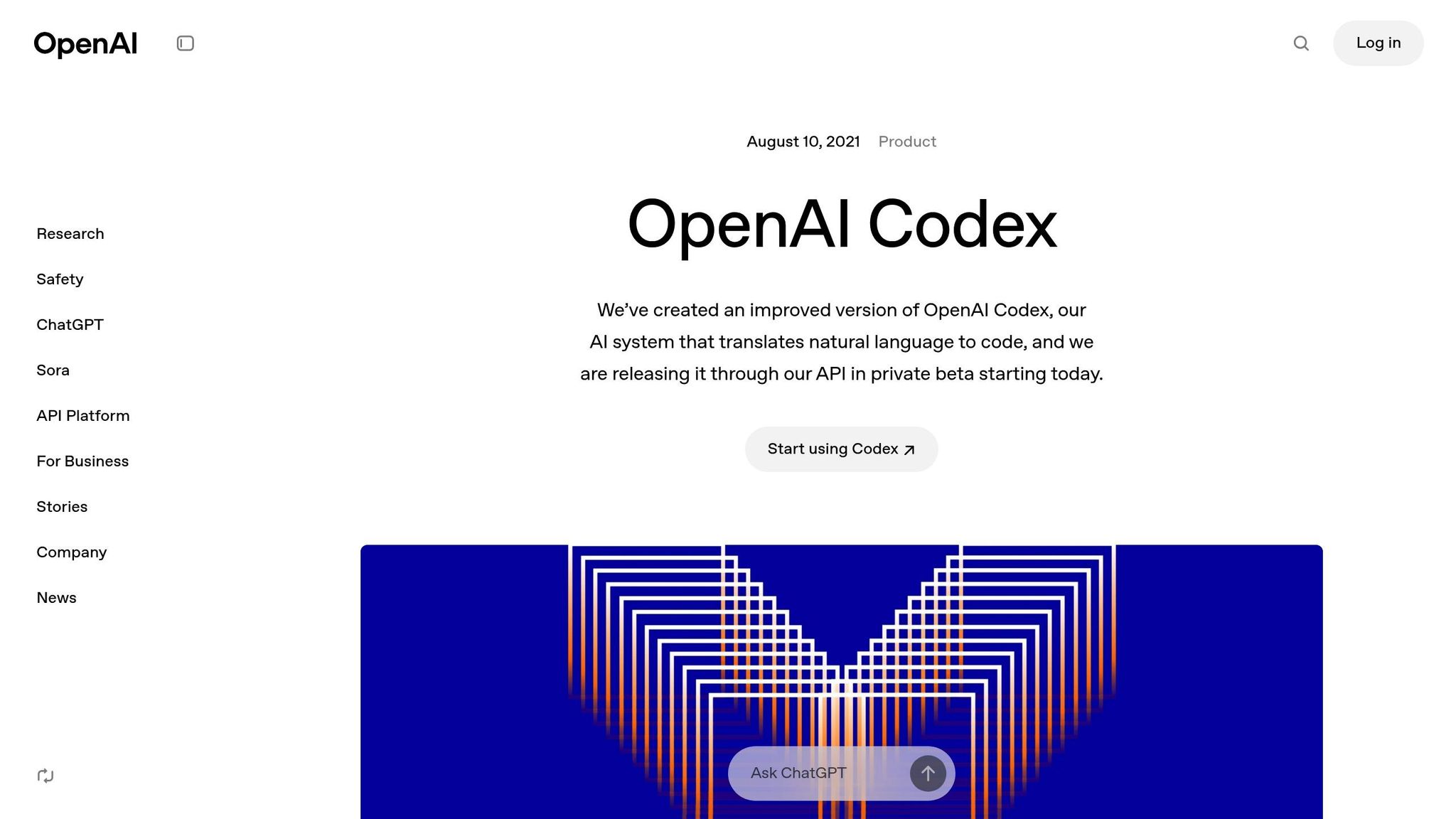
OpenAI Codex converts natural language into functional code across a variety of programming languages. It's built on 159 GB of Python code sourced from 54 million GitHub repositories, making it a powerful tool for accelerating development tasks.
Language Support and Capabilities
Codex works across several programming languages:
| Core Language | Additional Support |
|---|---|
| Python | JavaScript, Go, Perl, PHP |
| Further Languages | Ruby, Swift, TypeScript, Shell |
| Query Language | SQL |
| Memory Capacity | 14KB for Python (3.5× more than GPT-3) |
Performance Metrics
- Produces working solutions for 70.2% of prompts with multiple attempts.
- Achieves a 37% success rate on first attempts.
- Powers 35% of the code suggestions provided by GitHub Copilot.
Practical Applications
Codex supports a range of development tasks:
| Task Type | Example Use |
|---|---|
| Code Generation | Turning comments into executable code |
| Code Completion | Completing partial functions or lines of code |
| API Integration | Suggesting and implementing libraries and APIs |
| Improving Code | Adding comments or optimizing efficiency |
| Code Translation | Converting code between different programming languages |
Best Practices for Better Results
To get the most out of Codex, follow these guidelines:
- Clearly specify the programming language and version.
- Use prompts with detailed and descriptive comments.
- Include any required libraries or frameworks.
- Keep requests focused and to the point.
These steps help ensure Codex delivers accurate and useful outputs for your projects.
Real-World Impact
Codex has proven its value in real-world development, simplifying workflows and improving code quality.
"Codex is a way of getting code written without having to write as much code, and that it is not always correct, but it is just close enough."
- Jeremy Howard, co-founder of Fast.ai
"Codex-powered command search has become one of our game changing features."
- Zach Lloyd, Founder, Warp
"Codex is an amazing tool in our arsenal. Not only does it allow us to generate more meaningful code, but it has also helped us find a new design of product architecture and got us out of a local maximum."
- Vladislav Yanchenko, Founder, Machinet
Security and Training
Codex is trained on publicly available code repositories. However, developers should carefully review its output to ensure security and efficiency before using the code in production.
Integration Capabilities
Codex integrates smoothly with various tools and platforms, including:
- Visual Studio and VS Code
- Popular APIs and frameworks
- Command-line interfaces
- Platforms like Replit
"Codex helps learners on Replit better understand code they encounter. We've only scratched the surface of what semantic code understanding can offer those who want to get from idea to working code quickly."
- Amjad Masad, Founder, Replit
9. Replit Ghostwriter
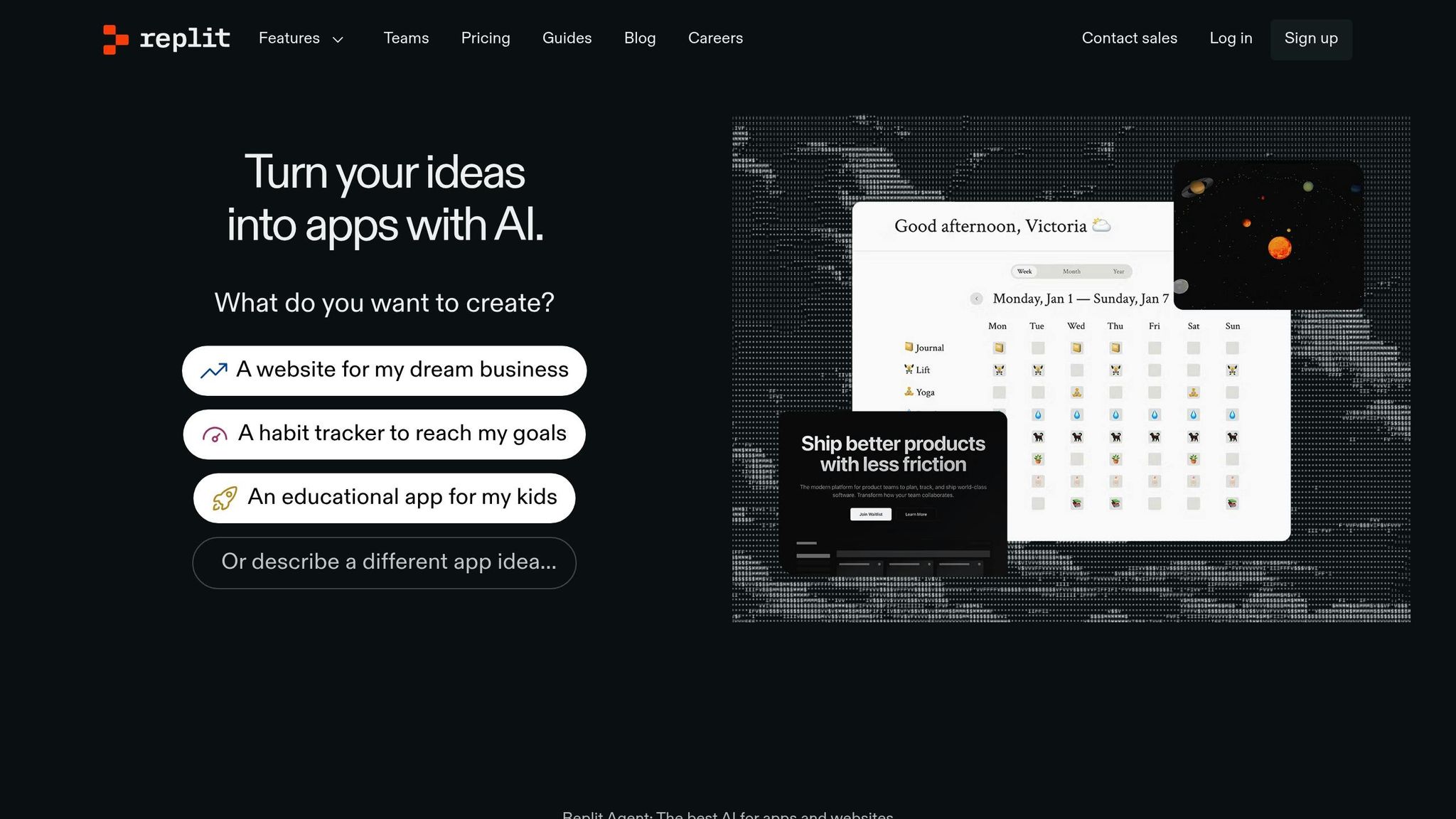
Replit Ghostwriter is an AI coding assistant built into the Replit online IDE. It provides real-time code suggestions for over 50 programming languages. Similar to tools like GitHub Copilot and Tabnine, Ghostwriter offers intelligent coding assistance but stands out with its seamless in-editor experience. With a median response time of under 400ms, it simplifies coding with several standout features.
Core Features
| Feature | Description |
|---|---|
| Complete Code | Provides real-time, in-line code suggestions |
| Explain Code | Breaks down code into plain English steps |
| Transform Code | Refactors code quickly |
| Generate Code | Converts natural language into code |
| Bug Detection | Identifies potential issues proactively |
Performance and Integration
Ghostwriter's "Complete Code" acts as an AI-powered coding partner, delivering suggestions tailored to your project's context. Its in-editor search makes it easy to find and import open-source code. These tools save time and effort in daily programming tasks.
Practical Applications
Ghostwriter is particularly helpful for:
- Automating Boilerplate Code: Reduces repetitive coding tasks.
- Code Refactoring: Simplifies and optimizes existing code.
- Learning Support: Explains difficult coding concepts.
- Natural Language Processing: Translates plain English into functional code.
Pricing Structure
Replit Ghostwriter is available in two tiers:
- Free Version: Offers limited AI features.
- Replit Core: Unlocks full AI functionality for $20 per month.
For advanced editing, there's a charge of $0.05 per edit. Core subscribers receive $25 in monthly credits.
User Feedback
Users have reported writing up to 50% less code manually, significantly improving productivity. Its ability to teach new coding concepts directly within the IDE makes it especially useful for learners.
Tips for Getting the Most Out of Ghostwriter
- Use Real-Time Features: Take advantage of instant code suggestions.
- Provide Feedback: Rate the AI's suggestions to improve accuracy.
- Be Specific with Prompts: Detailed prompts lead to better results.
- Enable Auto-Apply: Let the Advanced Assistant make edits automatically.
Performance Metrics
Ghostwriter's performance has been rated as follows:
- Latency: 8/10
- Quality: 6/10
- Features & Price: 3/10
While it may not outperform competitors like GitHub Copilot in all areas, Ghostwriter is a solid choice for educators, students, and hobbyists looking for an AI-powered coding assistant.
10. AI Apps
This directory takes coding assistants to the next level by compiling a wide range of AI tools designed to simplify your development workflow.
AI Apps features a curated collection of over 1,000 AI tools and resources. It’s a go-to platform for developers looking to enhance their projects with solutions for tasks like code generation, debugging, and project management.
Platform Overview
The platform organizes its vast collection into categories like code generation, debugging, project management, and testing. With a rigorous verification process, developers can rely on the quality and reliability of the listed tools.
Free Tools to Explore
Some standout free tools include:
- Amazon CodeWhisperer: Offers AWS-optimized suggestions and security tips.
- Codeium: Provides unlimited code completions across various programming languages.
- Stable Code 3B: Focuses on advanced code generation for non-commercial use.
Quality Assurance Concerns
While AI tools can speed up coding, they may introduce challenges. Bill Harding, founder of GitClear, explains:
"What we're seeing is that AI code assistants excel at adding code quickly, but they can cause 'AI-induced tech debt.'"
Why Integrate AI Tools?
AI tools are expected to play a massive role in the global economy, potentially adding $15.7 trillion by 2030, according to PwC's Global Artificial Intelligence Study. These tools can automate repetitive tasks, identify security issues, improve performance, and simplify documentation, making development workflows more efficient.
Tips for Using the Directory
- Filter tools based on your project’s stage.
- Compare free tiers to find the best options.
- Check for IDE compatibility.
- Review user feedback for insights.
With regular updates, this directory ensures developers have access to high-quality AI tools, making it easier to find and adopt the right solutions for every phase of a project.
Conclusion
AI tools are transforming how developers work, making processes faster and improving code quality. These free tools are changing the coding landscape in 2025, helping developers maintain high standards while boosting productivity.
Impact on Development Efficiency
Studies indicate that AI tools are significantly increasing productivity for development teams. This improvement encourages smart decisions when selecting tools.
Tips for Choosing AI Tools
When picking AI tools for development, keep these points in mind:
- Integration: Check if the tools work with your IDE and support your programming languages.
- Security: Ensure the tool generates original code and respects data privacy.
- Code Quality: Use free trials to test how well the tool performs and the quality of its suggestions.
Handling AI-Generated Code
AI tools bring many benefits, but they need careful use. Bill Harding, founder of GitClear, explains:
"Fast code-adding is desirable if you're working in isolation or on a Greenfield problem. But hastily added code is caustic to the teams expected to maintain it afterward."
Getting the Most Out of AI Tools
- Set Clear Standards: Define quality benchmarks for AI-generated code and enforce strict testing.
- Use Feedback Loops: Continuously improve prompts and refine tool usage.
- Combine Tools: Use multiple AI tools together to handle different tasks effectively.
- Track Results: Measure productivity beyond surface-level metrics to truly assess tool impact.
Professor Armando Solar-Lezama of MIT warns:
"AI is like a brand new credit card here that is going to allow us to accumulate technical debt in ways we were never able to do before."
To succeed, developers need to regularly evaluate and thoughtfully integrate AI tools into their workflows. By balancing automation with attention to code quality, teams can unlock the full potential of these tools while steering clear of common challenges.



